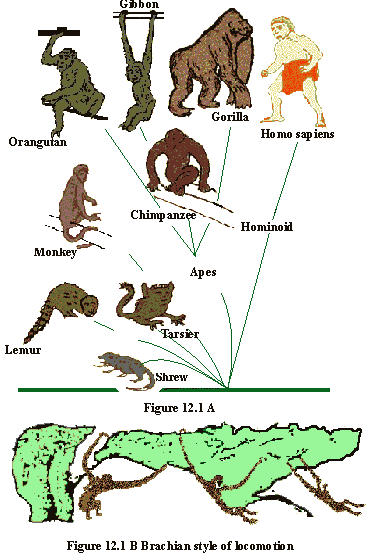|
PinkMonkey Online Study Guide-Biology
CHAPTER 12 : HUMAN EVOLUTION
12.0 Introduction
All humans are members of the
species Homo sapiens (Latin = "man who is wise"). Today,
man may be considered a dominant species on the earth due to his:
(1) Accumulation of achievements
(e.g., language, tools and methods developed to feed and, shelter, organization
in groups, achievements in arts, commerce and science); and
(2) Cultural and biological
evolution due to biological attributes or characters
such as (a) excellent stereoscopic vision(b), a large brain with a unique
capacity for learning and reasoning. (c) hands that can grasp and manipulate
objects. (d) upright bipedal (two-footed) posture. (e) specialized teeth
for an omnivorous diet. (f) presence of the foramen magnum below
the cranium so that the head can be moved about freely. These biological
characteristics appeared gradually over 70-80 million years of primate
evolution.
Homo sapiens belongs to
the mammalian Order-Primates which also includes tree shrews, tarsiers,
lemurs, lorries, monkeys and apes. The primate order is divided into :
(1) Sub-order - Prosimi
(Pro = almost, Simians-apes) e.g. lemurs, lorries, tarsiers, shrews.
(2) Sub-order - Anthropoidea
(Anthrop = man, oid = like) e.g. monkeys, apes, humans are closely
related species are placed in super family - Hominoidea (man-like).
Present and past Hominoids having man-like features are placed in family
- hominidae. There were at least two species of the genus Homo
(Homo habilis and Homo erectus), but the only living survivor
is Homo Sapiens.
We place ourselves in the order
Primate because we resemble the Primates more than any other animal.
Before we get to know our ancestors, the major groups of primates (Figure
12.1 A) related distinctly to human evolution are :
Tree shrews - which resemble
those mammals from which the primates arose.
Tarsiers - with long tails,
long hind limbs, stereoscopic vision, improved grip form, the most advanced
prosimians because they are like the monkeys.
Lorises and Lemurs
- which colonized early in their evolutionary history, until humans arrived
some two thousand years ago.
Monkeys - can walk upright,
they are relatively intelligent, live in groups, females care for the
young, they have larger brains than prosimians, and have stereoscopic
and color vision.
Apes - are the closest
kin to humans in size, form, physiology and behavior. They have bigger
brains, and brachian style of locomotion (swing by their arms as
shown in figure 12.1B) which is related to the evolution of an erect body
posture and elongation of arms. Apes and humans constitute the hominoids.
Besides humans, gibbons, orangutans, chimpanzees
and gorillas are the only living forms of hominoids. Gibbons and
orangutans are arboreal brachiators. Orangutans, chimpanzees and gorillas,
when on ground walk on all fours, supporting their weight on their fists,
(called - knuckle walkers). Chimpanzees and gorillas are
more intelligent, can use simple tools and have the ability to learn sign
language.
 Studies of DNA sequences have
shown that humans are more closely related to chimpanzees than to any
other primates. Human and chimp DNA are 99 percent identical; but that
is not to say that the humans have descended from fossil chimps. Fossil
records shows that humans and apes have both descended from a common ancestor,
or such genera as Dryopithecus, Ramapithecus and Sivapithecus
which lived in Africa and Asia. A brief account of various genera related
with human evolution is adressed in section 12.3.
|